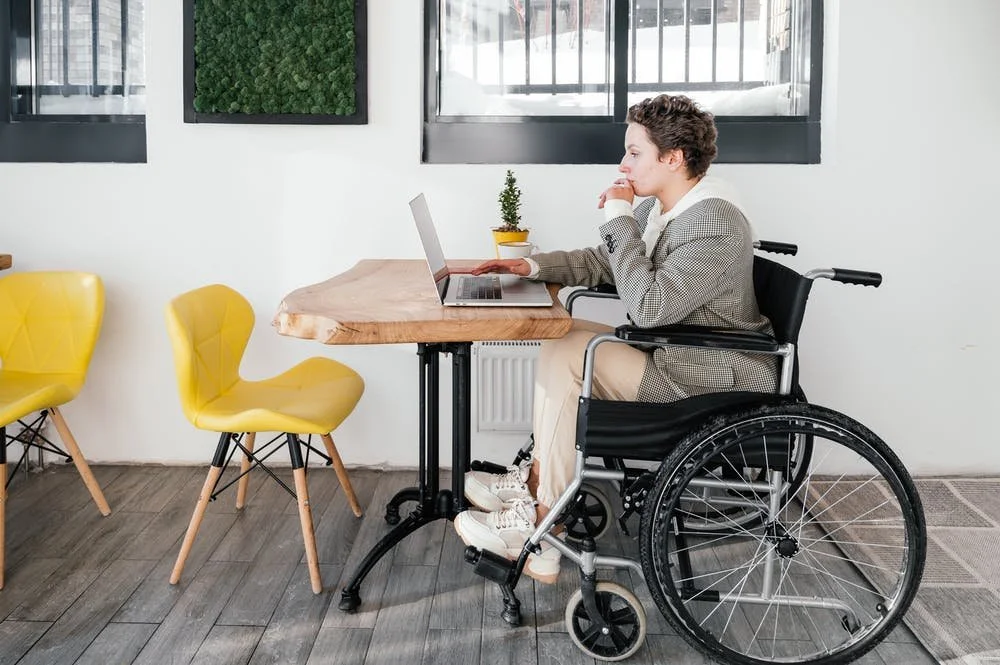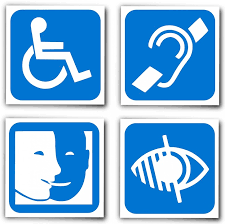The Growing Bedbound Talent Pool: The Impact of the Surge of Spinal Leaks Among Women in the US
Image Description: A young woman with a neutral expression on her face lies on the white sheets of her bed, turned away from her laptop, notepad, and cup of coffee. She takes a break with her eyes closed.
By Marion Davis
Emphasizing inclusion for mostly and fully bedbound disabled talent in a company’s employer brand can create a mutually beneficial situation. In a review of an often-overlooked talent group, this article will address the intersectional group of the millions of positionally disabled working-age women with spinal leaks in the US. Companies can create a highly unique employer brand that stands out from competitors while creating tailored onboarding practices that eliminate access barriers for women with spinal leaks to re-enter and participate in the workforce.
As an even more unique attribute of investing in women with spinal leaks, corporations can recognize that this population often consists of women with impressive professional backgrounds who were grounded suddenly with a spinal leak as an injury that is typically highly fixable.
At times, stories make the news of women who were bounced around from one healthcare provider to another only to be told consistently to lie in bed and accept a life of misery. These women were able to be upright and mobile again, participating in society with a high quality of life with a simple, minimally invasive procedure. The reason why these women are commonly unable to access appropriate and competent care will be outlined in more detail below, but the situation often becomes the patient versus the US healthcare system that is disinterested in listening to patient stories and fixing the root issue.
In the below sections, this article describes the specific limitations that spinal leaks create as a positional disability and the need for appropriate accommodations, the spinal leak situation in the US, the steps corporations can take to improve women’s access to proper spinal leak treatment, and then a look at a real story of a woman with a spinal leak and the common situation she faces of having to pivot her career.
Developing Disability Awareness with a Focus on Mobility Disabilities and Positional Disabilities
Strides in disability awareness should include a look at specific disability types for a better understanding of trends in the workforce and a better understanding of the accommodation needs that may emerge.
Employment Rates by Gender and Disability Type
In a recent report by the US Bureau of Labor Statistics, working-age men with disabilities were more likely to be employed than working-age women with disabilities. Working-age women without disabilities were employed at a rate of 70.1% in contrast to women with disabilities at 37.1%. Disabled women are at a higher risk of poverty than disabled men which leads to a lack of financial resources to develop skills and pursue further education, and thus these women are trapped in a cycle of poverty.
The experiences of people with physical disabilities are often overlooked. In fact, in one article from 2007 on the subject, working-age women with physical disabilities were noted as being approximately 10% less likely to be employed more than 15 hours per week than women with sensory disabilities and three percent less likely to be gainfully employed than men with physical disabilities.
Few reports break down unemployment by disability type. However, in a review of employed adults with a disability in the US in 2021, people of all genders with a hearing disability (as a sensory disability) were still the most represented subgroup within disability types by far at 56%.
There seem to be several factors at play here. Mobility disabilities as a physical disability often highlight more substantial accessibility barriers such as wheelchair-inaccessible buildings and public transportation options. Additionally, many people lack an understanding of the wide variety of mobility disabilities.
Positional Disabilities as a Subtype within Mobility Disabilities
Orthostatic (positional) disabilities have been on the rise in recent years. Long COVID led to a surge in millions of people in the US diagnosed with Postural Orthostatic Tachycardia Syndrome (POTS)--a mobility disability in which being upright causes disruption in many systems from heart rate to blood pressure to cognitive status and more.
While COVID has been a more recent trigger, there has long been another known cause of positional symptoms that can cause secondary POTS: spinal CSF leaks.
Understanding the Term “Bedbound”
People who must spend most of their time lying flat in bed due to positional symptoms can face disbelief when using the term “bedbound.” People with spinal leaks may have to lie flat for 20 to 22 hours out of a day and then be able to walk around the house for the other few hours. Typically, people with spinal leaks are more functional in the morning. Such a situation can result in disbelief from others similar to what ambulatory wheelchair users face where there is an idea that using a wheelchair is an all-or-nothing need.
Individuals in the ME/CFS community have assembled charts to explain the dynamic nature of ME/CFS as a similar condition–outlining stages of being only mildly limited by their symptoms, “mostly homebound” and then fully homebound, and “mostly bedbound” and then fully bedbound. This is a similar situation to that of people with spinal leaks. However, spinal leaks are not typically progressive in their debilitating effect; instead, the level of immobility can fluctuate widely based on factors ranging from hormonal cycles to medication reactions to any movement or action that injures the site further.
Some people with spinal leaks may be physically able to be upright all day and even be very active. However, at the same time, they may have noticed that their persistent neck pain and their feeling of a heavy head are improved if they lie flat. Sitting at a computer for long hours can be painful, and they may need to take breaks to lie down. This group can still be dealing with impacting secondary health factors such as gut motility issues which correlate with brain injuries and spinal leaks, feelings of fatigue, and struggles with insomnia–among other symptoms.
Greater Disability Awareness as an Investment
With greater disability awareness, companies and recruiters can understand the experiences of women with POTS secondary to spinal leaks as a mobility disability that is rapidly on the rise with unique accommodation needs. This greater disability awareness allows companies to publicly state their goals of inclusion for this often-overlooked disability type as well as adjust their recruiting and hiring practices to tap into the immense talent held by this subgroup of women who often had a thriving and industrious career before their life was put on hold. Furthermore, as these women often need support in pivoting their career to one they can perform from bed and as a spinal leak is a highly repairable injury with appropriate care, companies can recognize the investment potential in specifically seeking out women with spinal leaks and providing accommodations, career advancement support, and health and wellness support.
Understanding the Spinal Leak Epidemic
This section will first explain the anatomy involved in a spinal leak and then explain the gaps in care, the existence of a hidden population of talent, and the numbers involved in this epidemic to give a better look at the population size.
The Anatomy of a Leak
A spinal CSF leak is a hole in the dura–the lining around the spinal cord. This lining allows spinal fluid to travel around the spinal cord and up to the head where a person’s brain is lifted in buoyancy. The purpose of spinal fluid is to clean, cushion, and cool the brain. With a hole in the dura around the spinal cord, the fluid takes the path of least resistance and escapes out of the hole in a person’s back rather than traveling against gravity up to the head. What happens as a result is a wide range of symptoms and nothing short of neurological torture for the person in question.
The cause of a spinal leak these days is most often due to medical injury. A lumbar puncture involves a spinal needle intentionally puncturing the dura. An epidural is not meant to puncture the dura but accidental punctures do occur. These accidental punctures can often occur in scenarios such as labor epidurals, especially where the anesthesiologist is rushing. For labor epidurals, the accidental puncture rate that causes a spinal leak is listed as ranging from one percent to five percent or more.
The solution is simple for many cases and is the epidural blood patch. The epidural blood patch was discovered back in the 1960s. Physicians can draw blood from the patient and inject this blood using an epidural needle as well.
The American Society of Anesthesiologists (ASA) highlights an article by Shin (2022) as one of the most current and comprehensive guides to care. This article–like so many others by anesthesiologists around the world–touts that the epidural blood patch has withstood the test of time and still is the “gold standard” for treatment. Decades of published research come to this same conclusion independently. Yet, without a standard of care for spinal leaks, medical education programs can teach residents and fellows whatever they wish about spinal leaks–and not according to a certain research-backed standard.
Current Gaps in Care
Spinal leaks are often highly repairable in a minimally invasive procedure. However, citing low insurance reimbursement rates and a lack of training in medical education, physicians tend to be highly resistant to performing this procedure.
Common situations include:
failing to educate the patient on the risks before a medical procedure,
discouraging patients from looking into this diagnosis when symptoms emerge,
trying to upsell patients on more expensive pain-masking procedures other than epidural blood patches which fix the underlying injury,
requiring patients to endure another puncture as an expensive and unnecessary invasive test in order to access treatment and canceling the scheduled treatment following this test with the patient now more disabled, and/or
rushing the epidural blood patch while the physicians voice dislike of the procedure and cause further injury due to not following the recommendations for a slow and careful injection of blood into the epidural area.
Additionally, discrimination can play a major role in the ability to access care. The fix in the form of an epidural blood patch is made difficult to access for many women due to gender and ethnoracial discrimination.
Epidural blood patches as the necessary procedure to fix a spinal leak injury have become progressively de-emphasized in medical education over the past decade as a low-cost and time-consuming procedure. In one case, a pain management anesthesiologist had to use YouTube to learn how to perform the procedure in private practice.
While physicians often tell patients that a spinal leak will self-resolve after seven to 10 days, research and the patient experience have shown that the majority of women will tend to be symptomatic for years with persistent head and back pain after an accidental puncture that caused a leak during an epidural. Working-age women are both more likely to be going under the needle as well as biologically more likely than men to experience a spinal leak from a spinal procedure. Current research in anesthesiology professes that most women with a puncture will need at least one epidural blood patch and that an epidural blood patch is still the best way to repair a leak. Despite medical research encouraging repeat tries of an epidural blood patch until the patient can be upright again, physicians commonly refuse to provide any patches or more than one blood patch due to self-reported personal preferences as well as a self-reported lack of training during the physicians’ medical education experiences.
These women then bear the burden of costly and ineffective conservative symptom management. Women who do not know why they became disabled after their epidural or lumbar puncture are often shuffled around from physician to physician, building up medical debt and reducing the time they could spend on a life free of suffering. These women frequently had fruitful careers before gravity became their prison and an unlistening healthcare system became the prison warden.
The Numbers Involved in This Problem
Recent research following up with mothers a year or more after childbirth has revealed that around 60% of women still experience persistent symptoms following an accidental puncture of the spinal cord lining, with common symptoms being head and local back pain.
Taking into account all US mothers who had an accidental puncture during a labor epidural, the data suggests a puncture rate that would indicate that there are approximately 2,070,000 leaks annually from labor epidurals, and 60% of these cases persist due to inadequate treatment.
Considering the US population was 316 million in 2013 and 332 million in 2021, and factoring in the birth rate per woman, the underestimated rate of accidental punctures, and the frequency of women having persistent symptoms, this paper estimates that about 19 million women in the US may still be suffering symptoms from a spinal leak during a labor epidural between 2013 and 2021. This date range is given as an example of how quickly this problem is growing.
To put this in perspective, the total number of working-age women in the US as of 2023 is approximately 64 million according to FRED Economic Data.
This number does not come close to capturing the full picture as many women are being disabled by other spinal procedures such as epidural steroid injections, lumbar punctures, and spinal anesthesia, as well as being disabled by spontaneous spinal leaks.
What Companies Can Do as Part of Raising Disability Awareness for Spinal Leaks
For steps that companies can do as a part of raising disability awareness for spinal leaks, organizations can cultivate a greater understanding of spinal leak symptoms to understand how best to accommodate talent and employees, allocate a part of disability employee resource groups (ERGs) specifically to positional disabilities and spinal leaks, focus health and wellness programs on raising awareness of this issue as the healthcare system is failing to provide proper education, support their employees’ pursuit of care and streamline this process through B2B partnerships with remote care options, and ultimately improve their employer brand by showcasing their investment in gender equity.
Cultivate a Greater Understanding of Spinal Leak Symptoms
A spinal leak causes unique symptoms, with lying flat allowing the body to store spinal fluid in the head, originating primarily from the choroid plexus in the brain and circulating around the spinal cord. When a person sits or stands, gravity causes the fluid to fail to circulate back up to the brain due to an escape through a hole in the dura.
This creates an hourglass effect, where individuals have their own functional timers—some limited to lying flat, others able to sit up for only a few minutes. Remote jobs are more accessible for this population, but hiring practices emphasizing on-camera appearances can pose challenges.
Some recruiters equate lying down during video calls with laziness, overlooking the fact that severe spinal leaks often require lying flat for functionality. This neurological challenge is often misunderstood, leading to misinterpretations of women with spinal leaks as lazy.
Despite the hardships they face, individuals with spinal leaks exhibit remarkable creativity and innovation borne out of survival. Stories highlight the career challenges faced by those who were high achievers in lucrative positions, only to be bedbound overnight by a disabling spinal procedure. Access to remote jobs becomes crucial, but requirements to sit upright on camera can hinder career pivots.
Allocate a Part of Disability Employee Resource Groups (ERGs) to Positional Disabilities and Spinal Leaks
Disability Employee Resource Groups (ERGs) play a crucial role in creating an inclusive workplace culture. To address the unique challenges faced by individuals with positional disabilities like spinal leaks, companies can consider allocating a specific segment within their ERGs dedicated to positional disabilities and spinal leaks. This subgroup can provide a platform for employees to share their experiences, discuss potential accommodations, and raise awareness among colleagues and leadership about the specific needs of this overlooked community. Additionally, this subgroup can take steps to advocate for improvements to medical education in this area and to finally put in place a standard of care for spinal leaks in the US. Doing so would both ensure an easier and less traumatic and costly path to care for a company’s current employees with spinal leaks as well as set in place a safety net for their talent pool who–statistically speaking–are highly likely to experience a spinal leak in their lifetimes.
Focus Health and Wellness Programs on Raising Awareness of Spinal Leaks
Health and wellness programs are often designed to address common physical and mental health issues. To promote greater disability awareness, companies can tailor their health and wellness initiatives to include information and resources on spinal leaks. This may involve organizing workshops, webinars, or guest speaker sessions to educate employees about the symptoms, challenges, and accommodation needs associated with spinal leaks. By integrating spinal leak awareness into existing wellness programs, companies can contribute to a more informed and empathetic workplace.
Support Employees' Pursuit of Care and Streamline Processes Through B2B Partnerships with Remote Care Options
Recognizing the complexities of accessing appropriate care for spinal leaks, companies can take proactive steps to support their employees in seeking medical attention. Establishing partnerships with remote care providers or telemedicine services can streamline the process of obtaining timely and specialized care for employees with spinal leaks. In many cases, women may live in areas–both urban and rural–where private practice physicians refuse to provide services via telemedicine and insist that patients must be carted in on a stretcher to access preventive care and check-ups. In one case, a physician did not have an office at a building that could accommodate a stretcher but yet still insisted that patients come to him in person and hire their own ambulance to create a mobile office for him in the parking lot. The related costs of such an approach are extraordinary and take away from the time that the patient is functional and could be working.
In contrast, the rise of woman-owned digital health companies recognizes the issue of accessibility and is paving the way for a better future. Cash-based virtual services through large corporations like Amazon now make primary care accessible for people who are homebound. Companies can include these care membership plans as part of the benefits package that these organizations offer their employees with the recognition that patients with spinal leaks may be unable to access primary care normally due to inaccessibility at local practices. By facilitating access to healthcare resources, companies demonstrate a commitment to employee well-being and ensure that individuals with spinal leaks receive the necessary support to manage their condition effectively.
Improve the Employer Brand by Showcasing Investment in Gender Equity
As part of a broader commitment to diversity and inclusion, companies can enhance their employer brand by actively showcasing their investment in gender and disability equity, particularly in addressing the challenges faced by women with spinal leaks. This may involve highlighting success stories of how the company supported homebound employees in overcoming accessibility barriers, implementing inclusive policies and accommodations for positional disability, and participating in health advocacy efforts. A positive employer brand not only attracts top talent but also reflects the company's commitment to creating an inclusive and supportive work environment for everyone.
These suggested actions aim to empower companies to not only raise awareness about spinal leaks but also actively contribute to creating a workplace that accommodates and values individuals with positional disabilities. By taking steps to understand, support, and advocate for employees with spinal leaks, organizations can play a pivotal role in breaking down barriers and promoting true inclusivity.
Janel’s Story
The following account comes from Janel, a Korean adoptee who lives in the Northeast US and a spinal leak patient. Like many women in the US, Janel has been struggling to manage a work-life-health balance while dealing with a spinal leak for years. She is a retail florist who was professionally trained in her field with a physically demanding career that has more recently become impossible to maintain due to her increasing number of spinal leaks from medical procedures.
For the particular symptoms she experiences from her spinal leak, she has headaches and head pain when she is upright as well as a fast heart rate, dizziness, vertigo, panic attacks, and adrenaline surges. She also has myoclonus jerks (a short sudden movement similar to when you jerk awake but while you are already awake). Janel is plagued with back pain, blurry vision, tingling, severe fatigue, memory problems, cognitive issues, and many more symptoms. People with spinal leaks often experience very similar wide-ranging sets of symptoms which can decrease their access to proper spinal leak care as physicians posit that the body going haywire could not possibly have a singular root cause. Such a mindset in medicine can increase the cost of seeking care without a proper diagnosis as every symptom is assessed and managed separately. This situation can also increase stigma against patients as they are viewed as hypochondriacs or “too complex” with so many diagnoses in their charts.
As a disabled woman and Korean adoptee, Janel faces certain challenges with accessing care that take away from the time that she has available to work. When people with spinal leaks are already working on a limited timeframe in life, being disbelieved and facing medical discrimination in a healthcare setting rob a person of valuable time that could be spent on financial survival. Janel feels that many times when people are disabled, they must prove their disability over and over. Her multiple diagnoses make it difficult and time-consuming to find a doctor who does not treat her like a hypochondriac. The time expenditure on finding a physician who is not an ableist is immense for Janel. She has to carefully budget the time she has clearheaded after lying flat to try to find a compatible doctor who does not use her lack of family medical history against her as adoptees commonly report for their healthcare experiences. Janel also finds that physicians do not take into consideration that different races can have anatomical differences.
Throughout the entirety of her career, Janel has worked as a professionally trained florist. She chose to stay in retail floral as she has access to more benefits that she would not have available to her if she were working in a small shop or as an independent contractor. She considers herself to be very lucky that she has had long-term disability through her employer since her first CSF leak. Her employment status made it easier to transition to SSDI as well–although she had to sacrifice some of her artistic freedom to remain in retail floral. Janel had been on her way to a corporate job after working for the same company for 20 years but was so limited as her disability progressed largely due to repeat medical procedural errors and neglect. Sadly, Janel had to give up her small but profitable LLC where she created her unique floral arrangements for events and weddings. She was no longer able to design weddings or any other important occasion due to an ever-decreasing narrow window of functional time.
Many women with spinal leaks who became disabled in or after their 30s are in situations where they had a strong prior career but now must pivot to a work setup that they can perform on a flexible schedule and in a flexible format such as from home or from bed. Janel has turned her artistic eye to creating oil paintings at home and selling these to pay for medical bills. With the cognitive barriers she faces, Janel fears that cannot do work to learn something new. Her dream career pivot involves making enough art from home to pay for her ever-growing medical bills.
As far as sites and avenues that she uses to currently explore work opportunities, Janel finds that she has not been able to use most career or work platforms. Most of the available jobs or consulting projects that she reviews require her to work on location which presents a challenge due to her symptoms forcing her to lie flat often. Janel uses Facebook pages and search engines to look for additional ways to make income. Her friends and family are on the lookout for options for her as well. She recognizes that social media could provide her with more exposure for sharing her art, and she currently uses platforms like Etsy and Makers to showcase her work.
As far as her specific accommodation needs with a spinal leak, Janel would need to be able to lie down for video calls with a preference for no video in the call. She gets symptoms of sensitivity to noise as well at times, so she would need silence during these periods. The 9-to-5 is a common struggle for people with spinal leaks and Janel is no different as she needs to work on her body’s schedule and not a pre-set corporate schedule.
For her dream job, Janel would love to sell her artwork online. She started to paint as a therapeutic way to manage her conditions. Painting and selling her artwork online would give her the freedom to tap into her creative brain when she can and work from home as her symptoms make it a struggle to work traditionally with limited time upright.
Final Thoughts
The rising trend of spinal leaks among women in the US presents a significant yet often-overlooked talent pool with unique accommodation needs. Corporations stand to gain by cultivating greater disability awareness, particularly focusing on positional disabilities like spinal leaks. By actively addressing the challenges faced by women with spinal leaks, companies can not only enhance their employer brand but also tap into a diverse and skilled workforce. Recognizing the intersectional nature of this disability and the gender disparities in employment rates, companies can take concrete steps to promote inclusion, provide tailored support, and advocate for improvements in medical education and care standards. Ultimately, by embracing diversity and actively supporting employees with spinal leaks, corporations contribute to a more empathetic and inclusive work environment, creating a culture of genuine care and commitment to employee well-being.
Marion Davis is a contributing writer at EmployDiversityNetwork.com. She is a disabled DEIA consultant and writes on the value of diversity and inclusion across multiple industries, specifically as relates to disability and intersectionality.














